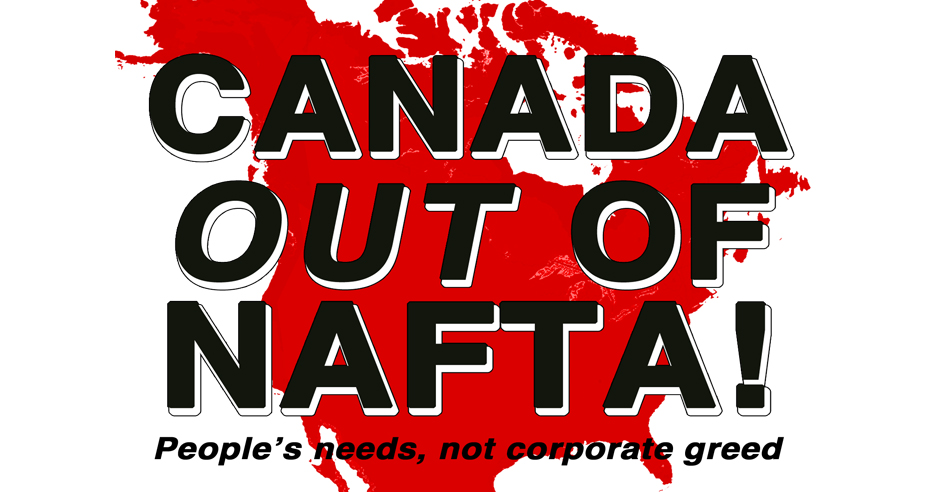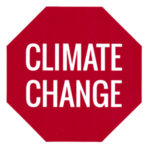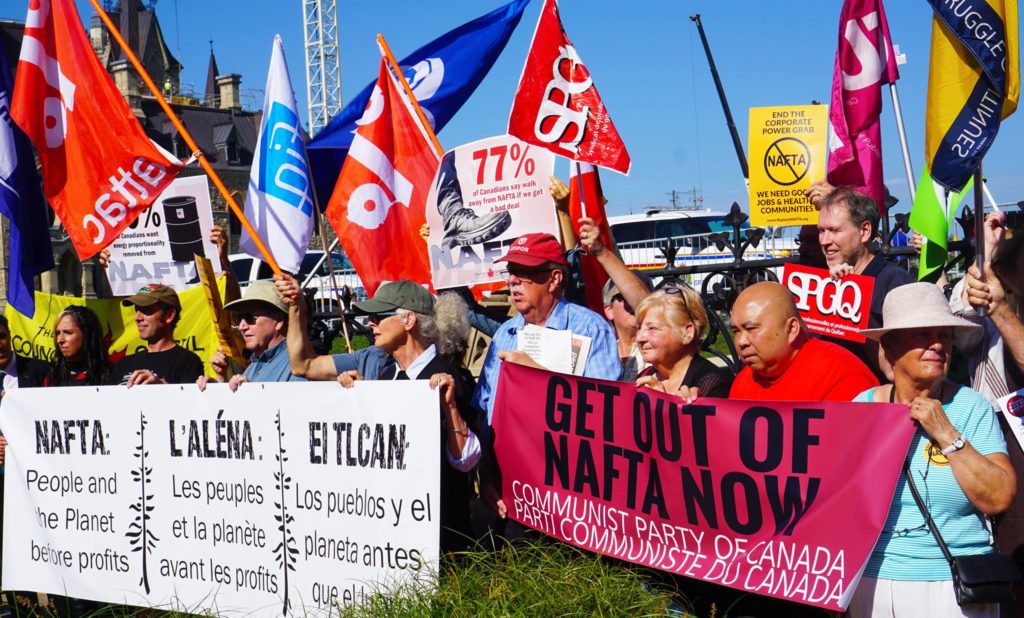Canada OUT of NAFTA: 9 things you should know about this corporate deal
 The “re-negotiation of NAFTA” is an attempt by the US to unilaterally dictate new terms of this anti-people corporate pact. The Communist Party says “no” to NAFTA, and “yes” to policies that put people’s needs before corporate greed.
The “re-negotiation of NAFTA” is an attempt by the US to unilaterally dictate new terms of this anti-people corporate pact. The Communist Party says “no” to NAFTA, and “yes” to policies that put people’s needs before corporate greed.
9 things you should know about NAFTA
1. Corporations can sue for “future lost profits”
 The Free Trade Agreement of 1988 fast-tracked Canada’s absorption into the US economic orbit. Four years later the FTA added Mexico to become NAFTA, which included Chapter 11, the Investor State Dispute Settlement (ISDS) mechanism that allows corporations to sue governments for “lost profits”. Under NAFTA, Canada has become the most sued country in the developed world.
The Free Trade Agreement of 1988 fast-tracked Canada’s absorption into the US economic orbit. Four years later the FTA added Mexico to become NAFTA, which included Chapter 11, the Investor State Dispute Settlement (ISDS) mechanism that allows corporations to sue governments for “lost profits”. Under NAFTA, Canada has become the most sued country in the developed world.
2. It’s not about trade, it’s about corporate profits
The promoters of NAFTA promised that expanded access to the US market would create thousands of jobs, raise wages and living standards, and open a new era of prosperity. Instead, “free trade” opened up Canada like a sardine can for large national and transnational corporations to maximize profits at the expense of our jobs and sovereignty.
3. NAFTA blocks action on climate change
 The energy proportionality agreement in NAFTA forces Canada to maintain oil and gas exports to the US, making it next to impossible to meet international commitments to reduce greenhouse gas emissions, by closing the tarsands, and developing alternative energy sources under public ownership and democratic control of energy.
The energy proportionality agreement in NAFTA forces Canada to maintain oil and gas exports to the US, making it next to impossible to meet international commitments to reduce greenhouse gas emissions, by closing the tarsands, and developing alternative energy sources under public ownership and democratic control of energy.
4. Disappearing jobs, wages and benefits
NAFTA encouraged corporate profiteering and impoverished millions of working people in all three countries. Wages and pensions were driven down. the Canadian steel industry was destroyed, more than half a million value added manufacturing jobs disappeared, and public services and social programs were slashed.
5. A massive wealth transfer to the 1%
 Under “free trade”, the policies of tax cuts, privatization, and deregulation redistributed wealth into the pockets of the 1% and sparked the 2008 crisis which rocked the global capitalist system. Now the Trump administration wants to slash corporate tax rates by 15%, repeal the Dodd-Frank Act (speeding up the next global financial crisis), and force Canada to adopt the same measures which triggered the last meltdown.
Under “free trade”, the policies of tax cuts, privatization, and deregulation redistributed wealth into the pockets of the 1% and sparked the 2008 crisis which rocked the global capitalist system. Now the Trump administration wants to slash corporate tax rates by 15%, repeal the Dodd-Frank Act (speeding up the next global financial crisis), and force Canada to adopt the same measures which triggered the last meltdown.
6. The US puts big tarrifs on Canadian exports
The US entered the renegotiations by putting a 20% tax on BC softwood lumber, and demanding removal of NAFTA’s Chapter 19 trade dispute panels, where Canada has consistently won in the long-standing fights over softwood lumber.
7. The US is coming back for what it didn’t get before
 The US wants Canada to yield on food sovereignty and supply management policies in agriculture, the single payer system in Medicare, public delivery of public services and social programs, culture, education, and rules of origin on automobile parts and assembly that will kill thousands more auto and manufacturing jobs in Canada. It’s the reason why Trump slapped a 300% tax on Canada’s aerospace industry. The goal is to shift manufacturing jobs to the US rust belt states, with anti-union “right to work” laws and lower wages.
The US wants Canada to yield on food sovereignty and supply management policies in agriculture, the single payer system in Medicare, public delivery of public services and social programs, culture, education, and rules of origin on automobile parts and assembly that will kill thousands more auto and manufacturing jobs in Canada. It’s the reason why Trump slapped a 300% tax on Canada’s aerospace industry. The goal is to shift manufacturing jobs to the US rust belt states, with anti-union “right to work” laws and lower wages.
8. Bad for farmers, bad for health
A new NAFTA would allow the export of more US goods into Canada, at the expense of Canadian producers and workers. This includes the over-supply of rBGH contaminated milk in the dairy states south of Quebec and Ontario, where supply management doesn’t exist.
9. “Side deals” are a sideshow
 In previous negotiations, “side deals” were supposed to protect labour and environmental standards. The US is willing to include these toothless side deals in the renegotiated NAFTA agreement – if they remain too weak to protect workers’ rights and the environment.
In previous negotiations, “side deals” were supposed to protect labour and environmental standards. The US is willing to include these toothless side deals in the renegotiated NAFTA agreement – if they remain too weak to protect workers’ rights and the environment.
Get OUT of NAFTA Now!
 Why “update” an agreement which ties Canada even more tightly to the US at a time of deepening economic and social crisis? And why placate Donald Trump by surrendering ever bigger chunks of our sovereignty and independence?
Why “update” an agreement which ties Canada even more tightly to the US at a time of deepening economic and social crisis? And why placate Donald Trump by surrendering ever bigger chunks of our sovereignty and independence?
Unlike PM Justin Trudeau, Mexico has also expressed serious concerns about the current US administration, and has discussed pulling out of NAFTA. Instead of getting in deeper, Canada should say goodbye to NAFTA while we can.
For good jobs and a People’s Recovery
A People’s Alternative to NAFTA would put people’s needs before corporate greed. Canada needs to rebuild manufacturing and secondary industry, and develop an environmentally sustainable industrial strategy. We should invest in mass public transit and inter-urban rail transit, creating new green jobs and expanding alternative energy sources within a publicly owned energy sector.
 We need to increase taxes on corporations and ease the load on working people and the unemployed. The Bank of Canada should be used to fund job-creating investments in post-secondary education, quality public childcare, and social housing at rents and prices people can afford. Medicare should be expanded to include dental and vision care, long term care and pharmacare. These policies could mean a genuine and long-lasting recovery for working people, including for hundreds of thousands of young people trying to get a foot in the door.
We need to increase taxes on corporations and ease the load on working people and the unemployed. The Bank of Canada should be used to fund job-creating investments in post-secondary education, quality public childcare, and social housing at rents and prices people can afford. Medicare should be expanded to include dental and vision care, long term care and pharmacare. These policies could mean a genuine and long-lasting recovery for working people, including for hundreds of thousands of young people trying to get a foot in the door.
Canada needs a new trade policy, based on multi-lateral and mutually beneficial trade with the world. Instead of backing US militarism, Canada should adopt a foreign policy of peace and disarmament, cut military spending by 75%, and redirect these billions to civilian priorities.
This is the way to a better future, not signing a new NAFTA that would transform Canada into the 51st US state.
